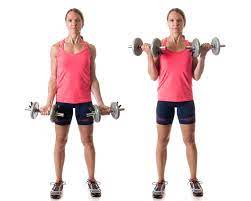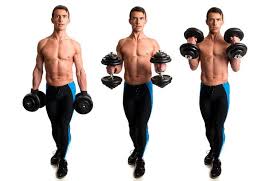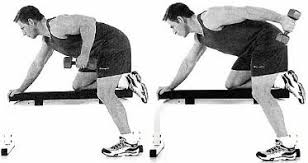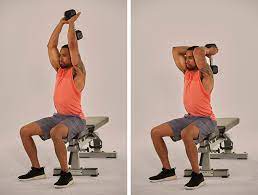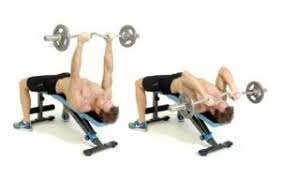About the arm muscles
Biceps Brachii
The biceps (Latin: musculus biceps brachii, "two-headed muscle of the arm", sometimes abbreviated to biceps brachii) is a large muscle that lies on the front of the upper arm between the shoulder and the elbow. Both heads of the muscle arise on the scapula and join to form a single muscle belly which is attached to the upper forearm. While the biceps crosses both the shoulder and elbow joints, its main function is at the elbow where it flexes the forearm and supinates the forearm. Both these movements are used when opening a bottle with a corkscrew: first biceps screws in the cork (supination), then it pulls the cork out (flexion).
The biceps works across three joints.[10] The most important of these functions is to supinate the forearm and flex the elbow. Besides, the long head of biceps prevents the upward displacement of the head of the humerus.
Proximal radioulnar joint of the elbow – The biceps brachii functions as a powerful supinator of the forearm, i.e. it turns the palm upwards. This action, which is aided by the supinator muscle, requires the humeroulnar joint of the elbow to be at least partially flexed. If the humeroulnar joint, is fully extended, supination is then primarily carried out by the supinator muscle. The biceps is a particularly powerful supinator of the forearm due to the distal attachment of the muscle at the radial tuberosity, on the opposite side of the bone from the supinator muscle. When flexed, the biceps effectively pulls the radius back into its neutral supinated position in concert with the supinator muscle.
Humeroulnar joint of the elbow – The biceps brachii also functions as an important flexor of the forearm, particularly when the forearm is supinated.[1] Functionally, this action is performed when lifting an object, such as a bag of groceries or when performing a biceps curl. When the forearm is in pronation (the palm faces the ground), the brachialis, brachioradialis, and supinator function to flex the forearm, with minimal contribution from the biceps brachii. It is also important to note that regardless of forearm position, (supinated, pronated, or neutral) the force exerted by the biceps brachii remains the same; however, the brachioradialis has a much greater change in exertion depending on position than the biceps during concentric contractions. That is, the biceps can only exert so much force, and as forearm position changes, other muscles must compensate.
Glenohumeral joint (shoulder joint) – Several weaker functions occur at the glenohumeral joint. The biceps brachii weakly assists in forward flexion of the shoulder joint (bringing the arm forward and upwards). It may also contribute to abduction (bringing the arm out to the side) when the arm is externally (or laterally) rotated. The short head of the biceps brachii also assists with horizontal adduction (bringing the arm across the body) when the arm is internally (or medially) rotated. Finally, the short head of the biceps brachii, due to its attachment to the scapula (or shoulder blade), assists with stabilization of the shoulder joint when a heavy weight is carried in the arm. The tendon of the long head of the biceps also assists in holding the head of the humerus in the glenoid cavity.
Source
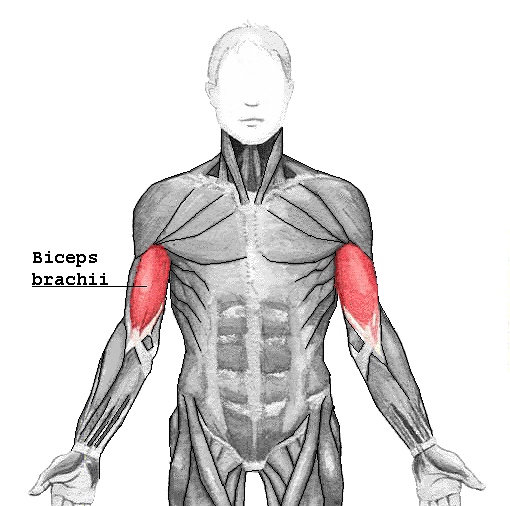
Triceps Brachii
The triceps, also triceps brachii (Latin for "three-headed muscle of the arm"), is a large muscle on the back of the upper limb of many vertebrates. It consists of 3 parts: the medial, lateral, and long head. [1]It is the muscle principally responsible for extension of the elbow joint (straightening of the arm).
The triceps is an extensor muscle of the elbow joint and an antagonist of the biceps and brachialis muscles. It can also fixate the elbow joint when the forearm and hand are used for fine movements, e.g., when writing. It has been suggested that the long head fascicle is employed when sustained force generation is demanded, or when there is a need for a synergistic control of the shoulder and elbow or both. The lateral head is used for movements requiring occasional high-intensity force, while the medial fascicle enables more precise, low-force movements. With its origin on the scapula, the long head also acts on the shoulder joint and is also involved in retroversion and adduction of the arm. It helps stabilise the shoulder joint at the top of the humerus.
Source
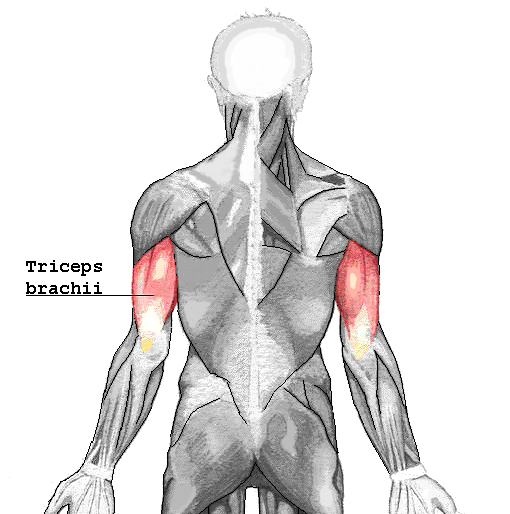
Brachialis
The brachialis (brachialis anticus) is a muscle in the upper arm that flexes the elbow joint. It lies deeper than the biceps brachii, and makes up part of the floor of the region known as the cubital fossa. The brachialis is the prime mover of elbow flexion. While the biceps brachii appears as a large anterior bulge on the arm and commands considerable interest among body builders, the brachialis underlying it actually generates about 50% more power and is thus the prime mover of elbow flexion. The brachialis flexes the arm at the elbow joint.[2] Unlike the biceps, the brachialis does not insert on the radius, and does not participate in pronation and supination of the forearm.
Source
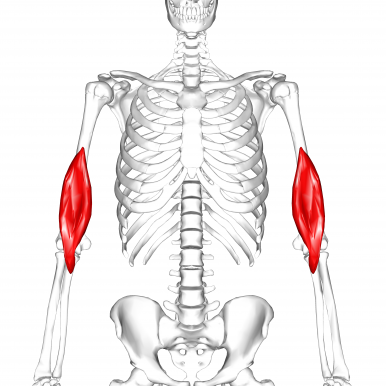
Coracobrachialis
The coracobrachialis is the smallest of the three muscles that attach to the coracoid process of the scapula. (The other two muscles are pectoralis minor and the short head of the biceps brachii.) It is situated at the upper and medial part of the arm.
The action of the coracobrachialis is to flex and adduct the arm at the glenohumeral joint (shoulder joint). Also, the coracobrachialis resists deviation of the arm from the frontal plane during abduction.[1] Therefore, the contraction of the coracobrachialis leads to two distinct movements at the shoulder joint. It both draws the humerus forward, causing flexion of the arm, and draws the humerus toward the torso, causing adduction of the arm. To a smaller extent, it also turns the humerus inwards, causing internal rotation.[2] Another important function of the coracobrachialis is the stabilization of the humeral head within the shoulder joint, especially when the arm is hanging freely at a person's side.
Source
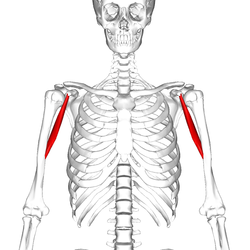
Exercises
Stretches
- Standing Bicep Stretch
- Interlace your hands at the base of your spine.
- Straighten your arms and turn your palms to face down.
- Raise your arms up as high as you can.
- Hold this position for up to 1 minute.
- Seated Bicep Stretch
- Sit with bent knees and your feet flat on the floor in front of your hips.
- Place your hands on the floor behind you with your fingers facing away from your body.
- Evenly distribute your weight between your feet, buttocks, and arms.
- Slowly scoot your buttocks forward, toward your feet, without moving your hands.
- Hold this position for up to 30 seconds.
- Return to the starting position and relax for a few moments.
- Wall Bicep Stretch
- Press your left palm against a wall or sturdy object.
- Slowly turn your body away from the wall.
- Feel the stretch in your chest, shoulder, and arm.
- Hold this position for up to 30 seconds.
- Repeat on the opposite side.
- Behind-the-Head Triceps Stretch
- Standing with your feet shoulder-width apart, extend your right arm over your head, and bend your right elbow, bringing your palm as far down your back as you can.
- Grab your right elbow with your left hand and gently pull it to the left until you feel a stretch.
- Hold for time, then switch arms and repeat.
- Standing Bench Triceps Stretch
- Stand with your right side toward an incline bench or other sturdy, chest-high structure and spread your feet slightly wider than hip width.
- Place your right elbow on top of the bench’s back support, and lower your body until you feel a stretch in your right triceps and lat.
- Hold for time, and then repeat on your other side.
- Towel triceps stretch
- Sit upright on the floor with your legs crossed, roll a towel lengthwise, and hold one end overhead in your right hand, allowing it to hang down your back.
- Keeping your chest lifted, lower the towel until you can grab the other end in your left hand.
- Maintain tension in the towel as you gently pull it as far down with your left hand as you can.
- Hold for time, and then repeat on your other side.
Injuries
By far, trauma and repetitive use are responsible for the majority of arm injuries and the most serious of these is when the biceps tendon is completely torn. Most commonly, the biceps tendon tears at the shoulder. Most injuries occur at 40 to 60 years of age due to chronic wear of the biceps tendon. In younger individuals, the tear is usually the result of trauma (such as an auto accident or fall). biceps tendon ruptures are also likely in individuals who perform repetitive overhead lifting and in athletes who lift weights or participate in aggressive contact sports.
A strain of the biceps or triceps tendon or a sprain of the muscle is more common (and less serious) than a compete tendon rupture. As noted in our prior blog, Major Differences Between Strains and Sprains, damage to the muscle is referred to as a sprain and damage to the tendon is referred to as a strain. Healthcare providers are seeing more arm strains and sprains with the growth of explosive sports and endurance sports such as Crossfit, power lifting and obstacle course racing (e.g. Spartan, Tough Mudder, etc). A pulled biceps results from overstretching and tearing some of the biceps muscle fibers and/or tendons.
Source

